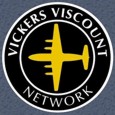
February 1955 to June 1964
Trans-Canada Air Lines (TCA)
CF-TGK - c/n 42 - a V.724 series Viscount
Canada registered
November 1952
An order was placed by Trans-Canada Air Lines (TCA) for fifteen Type 724 aircraft at a total cost of Can$11,500,000. This was the third one built.
Production Aircraft No. 48 - the 48th production Type 700 series Viscount built,
was the 16th Viscount fuselage assembled at Hurn, Bournemouth, Dorset, England,
and the 27th Viscount assembled at Weybridge, Surrey, England.
Production Order No. F03/724. Sales Order No. F03/51B. Stock Order No. F07/21B.
29 June 1954
Fuselage assembly commenced at Hurn Airport, Bournemouth, Hampshire, England.
August 1954
Fuselage transported by road from Hurn Airport, Bournemouth, Hampshire, England to Weybridge, Surrey, England.
16 August 1954
Fuselage to Erecting Shop 'E' at Weybridge, Surrey, England.
4 February 1955
First flight from Brooklands Airfield, Weybridge, Surrey, England.
It was fitted with Rolls-Royce Dart RDa3 Mark 506 engines.
It landed at Wisley Airfield, Surrey, England for fitting out and test flying.
24 February 1955
Aircraft passed off by TCA inspectors as completed and ready for delivery.
25 February 1955
Departed from Wisley Airfield, Surrey, England on delivery to Trans-Canada Air Lines (TCA) with fleet number '603'.
After refuelling at Prestwick Airport, Ayrshire, Scotland it then flew on to Keflavik Airport, Iceland (743 nautical miles) where it stopped for two nights. The reason for the delay is not known.
27 Febuary 1955
Departed from Keflavik Airport, Iceland to Bluie West One (BW1) Airfield, Narsarsuaq, Southern Greenland (804 nautical miles), Goose Bay Airport, Newfoundland & Labrador, Canada (672 nautical miles) where it stopped overnight.
BW1 was built during WWII to assist the transfer of military aircraft from North America to Europe and was opened in January 1942.
28 Febuary 1955
Departed from Goose Bay Airport, Newfoundland & Labrador, Canada to Dorval International Airport, Montreal, Province of Quebec, Canada (810 nautical miles).
The aircraft then went to Winnipeg Airport, Manitoba, Canada.
The cabin seating was installed in Canada, as the seats used by TCA were of American manufacture.
The cabin was fitted out with 40 seats which was a reduction from the original 48 seat specification and provided more leg room.
This was heavily marketed and resulted in a high load factor compared to the 18 seat Douglas DC-3 that it replaced on some routes.
21 March 1955
TCA issued technical instruction V-05.04-1/1 to apply the word 'Viscount' to the tail section in 8.5 inch high red letters edged in white at the first opportunity.
1 April 1955
This aircraft operated the first turbine powered scheduled revenue service in North America from Dorval Airport, Montreal to Winnipeg Airport via Malton Airport, Toronto and Fort William Airport (now known as Thunder Bay), Ontario, Canada.
Chief Pilot Walter H Kent was in command accompanied by Captain David F Tribe who was being checked out on the Viscount.
4 April 1955
Operated the first international turbine powered scheduled revenue service in North America from Malton Airport, Toronto, Canada to Idlewild Airport, New York, USA with 40 passengers on board, departing at 09:00 local time.
2 June 1955
TCA issued technical instruction V-31.02-2/5 to apply the word 'Viscount' to the inside of the passenger loading door in 4 inch high red letters edged in white at the first opportunity.
8 August 1955
Operated the first service from Dorval International Airport, Montreal, Province of Quebec, Canada to Idlewild Airport, New York, USA, which was a three times a day service.
July 1956
Cabin interior changed to a two class 44 seat arrangement.
10 July 1957
TCA issued instructions that all Viscounts would be repainted in a 'White Top' livery when a suitable maintenance period became available.
31 August 1960
Total time 13,875 hours and 10,874 total landings.
1 June 1964
Transferred to Air Canada due to a corporate name change.
|



